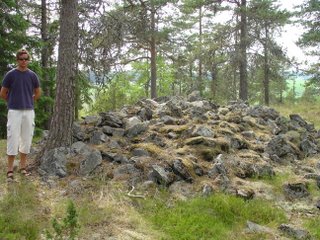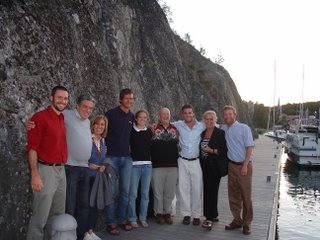June 19, 2006
Ship’s Log
June 19, 2006
Departure Location: Hangö, Finland
Departure Time: On Shore
Distance Traveled. On shore
Arrival Location: Hangö, Finland
Arrival Time: On Shore
Weather: Highs in the 90s and clear blue skies.
Personal Comments:
Today we began our exploration of the area surrounding Troy (Toija in Finnish) with a gracious guide, Jana Shelby. She is involved with many of the community efforts to publicize and promote the Trojan background. Jana has been in contact with Vinci and his work since the early 90s and is organizing a major festival for the summer of 2007 whose central theme will celebrate the connection between Finland and Homer’s Epics.
After guiding us around many relevant sights Jana invited us back to her home where she served us traditional Finnish sausage and introduced us to her five wonderful children and her welcoming Texan husband, Stephen. Over dinner we got to hear a first hand account from Stephen regarding the transition to a northern environment and the cumulative effect of living with so little daylight during much of the year.
Research Comments:
Most of the day was devoted to visiting sites surrounding Troy. We made our first stop at Tenela, which is where Vinci believes Tenedos was once located. Tenedos is one of the three sites where Apollo was worshipped in the initial passages of the Iliad. It is also mentioned twice in book one, specifically on lines 38 and 452. Other references can be found in book eleven on line 625, and in book thirteen on line 33.
Perniö was our next stop and the focus of our expedition. While there we were able to explore and document a series of burial mounds that sat atop a low wooded ridgeline. Although these tumuli now overlook farmlands, when the water was higher they sat just above the shoreline where they could be viewed by all those passing in ships. Burial mounds such as these have been used for many generations and for a variety of purposes. In the Iliad (Book 24 lines 80-84) the burial mound for Achilles is described in order to illustrate his greatness among the many warriors. However, in Book 7 of the Iliad (lines 85 to 90) Hector uses the tumuli to boast about how the burial mounds of the Acheans will serve to show all passing ships his greatness in having defeated such powerful warriors.
The use of these tumuli to mark the burial place of a great warrior is not a new phenomenon. Even though the Iliad is one of the oldest works to reference their use, there have been many other references since then. For example, lines 2803 -2808 in the classic epic Beowulf contains a description that is strikingly similar to that spoken by Hector in the Iliad.
The tumuli are also important because many of the Bronze Age swords and spearpoints that have been found in the area have come from these tumuli. There is currently a collection of these artefacts in the National Museum in Helsinki and we hope to photograph many of them while we are there on Wednesday.
For a general description of the importance of these tumuli see pages 119 to 120 in Vinci’s text.



0 Comments:
Post a Comment
<< Home